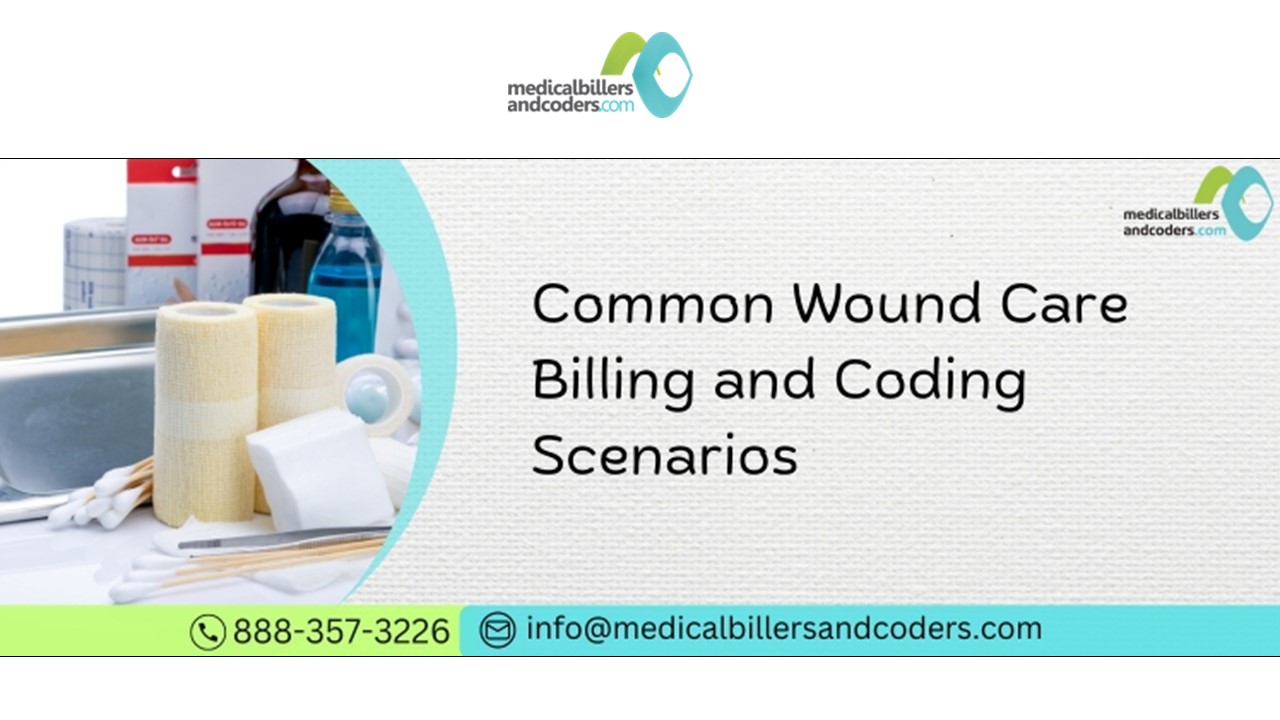Common Wound Care Billing and Coding Scenarios - PowerPoint PPT Presentation
Title:
Common Wound Care Billing and Coding Scenarios
Description:
Wound care billing and coding errors can lead to revenue loss. Here are some common factors to consider to streamline billing scenarios. – PowerPoint PPT presentation
Number of Views:5
Title: Common Wound Care Billing and Coding Scenarios
1
(No Transcript)
2
Common Wound Care Billing and Coding Scenarios
Understanding and managing wound care billing and
coding can be challenging, as it involves complex
procedures and constantly changing policies. As a
wound care specialist, your expertise lies in
treating and monitoring chronic, acute, and
non-healing wounds. Dealing with complex wound
care billing scenarios can divert your attention
from patient care. However, accurate wound care
billing and coding are essential to maximize your
revenue and ensure compliance. According to a
2018 study conducted by the American Medical
Association (AMA), medical billing errors
resulted in an average loss of approximately 7
of a physicians total annual revenue.
Source A 2018 study conducted by the AMA
3
Common Wound Care Billing and Coding Scenarios
- Wound care billing and coding can be a
challenging and complex process due to several
factors including - Extensive documentation requirements
- Coding complexities
- Reimbursement limitations
- Billing multiple payers
- Risk of fraud billing
- Common Factors to Consider for Effective Wound
Care Billing and Coding - Tackling the complexities of wound care billing
scenarios requires a detailed understanding of
various factors, including wound types, treatment
modalities, and coding guidelines. Heres how you
can navigate these intricacies effectively - 1. Understanding Wound Types
- Wounds come in different forms, such as acute,
chronic, surgical, or traumatic. Each type
requires specific documentation and coding to
accurately reflect the patients condition and
treatment.
4
Common Wound Care Billing and Coding Scenarios
2. Assessing Wound Healing You must be
acquainted with the stages of wound
healinghemostasis, inflammation, proliferation,
and remodeling. This knowledge will allow you to
conduct precise documentation of the wounds
progress and ensure accurate coding. 3.
Identifying Treatment Modalities Wound care
encompasses various treatment modalities,
including debridement, dressings, topical agents,
and advanced therapies like negative pressure
wound therapy. Knowing which modalities are used
and documenting them appropriately will help you
ensure accurate coding. 4. Documentation
Practices Accurate and thorough documentation
is the key to effective wound care coding. You
must properly document the type of wound, its
location, size, depth, and any associated
complications. Additionally, you should document
the treatment, modalities used, and changes in
the wounds status for accurate coding.
5
Common Wound Care Billing and Coding Scenarios
5. Coding Compliance Adhering to wound care
billing and coding guidelines is crucial to
ensure compliance and prevent errors. You must
stay updated on coding changes and guidelines
issued by organizations such as the Centers for
Medicare and Medicaid Services (CMS) and the
American Medical Association (AMA). 6. Training
and Education Staying updated with the latest
practices and updates in wound care billing and
coding through ongoing training and education is
essential. This can include participating in
workshops, seminars, or online courses dedicated
to wound care coding and documentation. Common
CPT codes for Wound Care Wound care encompasses
multiple procedures, each associated with its
specific billing code. 1. Debridement Services
6
Common Wound Care Billing and Coding Scenarios
CPT 11042 11047 These codes cover the
debridement of skin and subcutaneous tissue based
on wound size and complexity. 2. Skin
Substitutes and Grafts CPT 15002 15431 These
codes are used for applying skin substitute
grafts, varying by procedure and treated area
size. 3. Wound Repair CPT 12001 13160 These
codes are used for closures and repairs of
different complexities. 4. Wound Evaluation and
Management CPT 99201 99499 These codes are
used for evaluation and management services,
including outpatient visits. 5. Hyperbaric
Oxygen Therapy
7
Common Wound Care Billing and Coding Scenarios
CPT 99183 These codes are used for reporting
hyperbaric oxygen therapy in specific wound care
cases. How MBC can help Managing wound care
billing and coding amidst busy schedules and
heavy workloads can be daunting and stressful,
potentially leading to errors and revenue loss.
Outsourcing could be the solution to prevent
billing and coding errors. Medical Billers and
Coders (MBC) can assist you in streamlining wound
care billing scenarios, allowing you to focus on
patient care.
8
Common Wound Care Billing and Coding Scenarios
Dont let complex wound care billing scenarios
hold back your potential revenue. Contact MBC
today to streamline wound care billing and coding
and optimize your practices financial
health. FAQs Q What are the different types
of wounds that require accurate coding? A There
are different types of wounds including acute,
chronic, surgical, and traumatic. Accurate coding
requires precise identification and documentation
of each wound type. Q When should the LT and RT
modifiers be used in wound care coding? A The
LT modifier is utilized to specify the location
of the wound on the left side of the body, while
the RT modifier indicates the location of the
wound on the right side. Q Why is partnering
with MBC beneficial for wound care
specialists? A MBC offers specialized expertise
in wound care billing and coding, streamlining
revenue cycles and optimizing reimbursement,
allowing wound care specialists to focus on
patient care.































